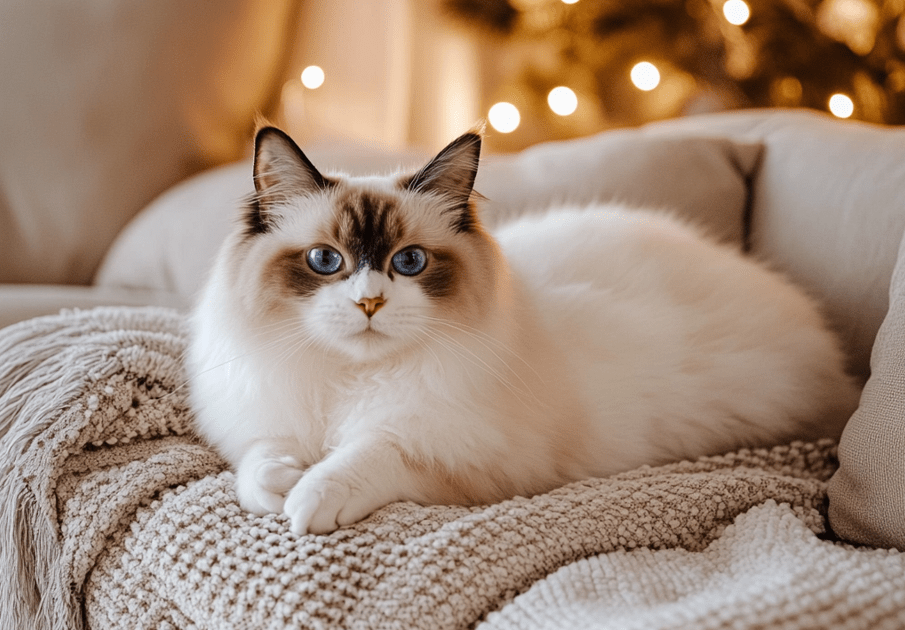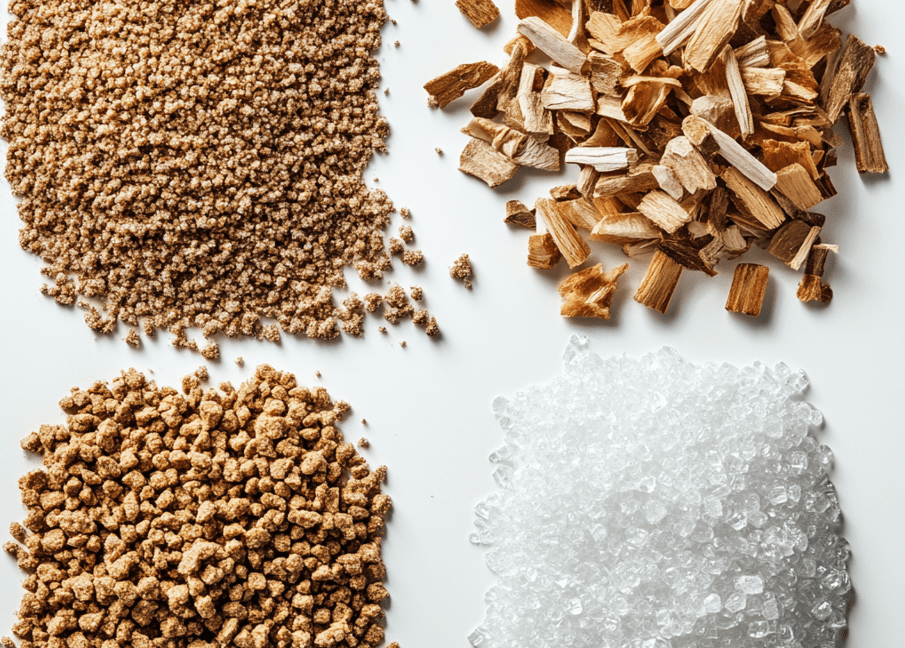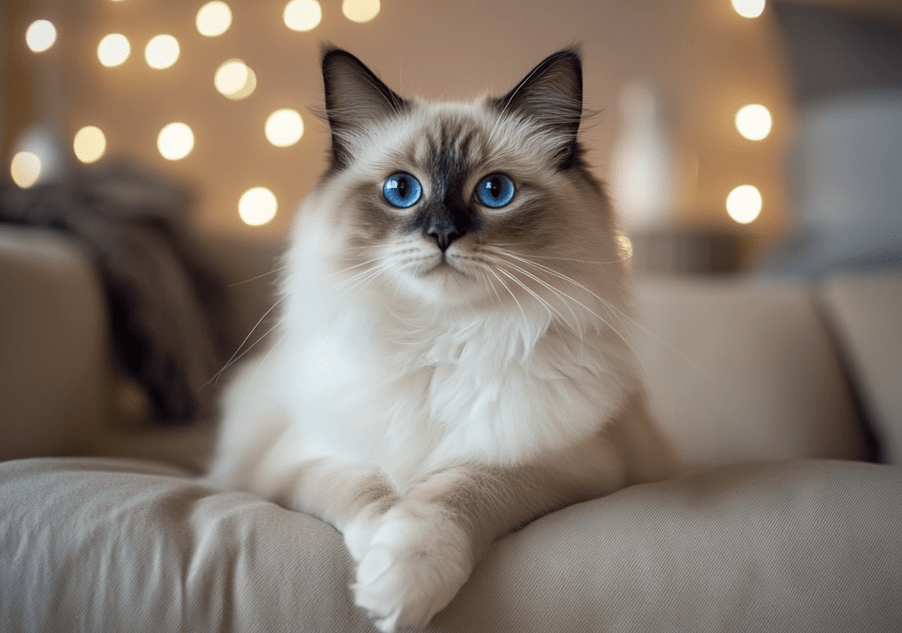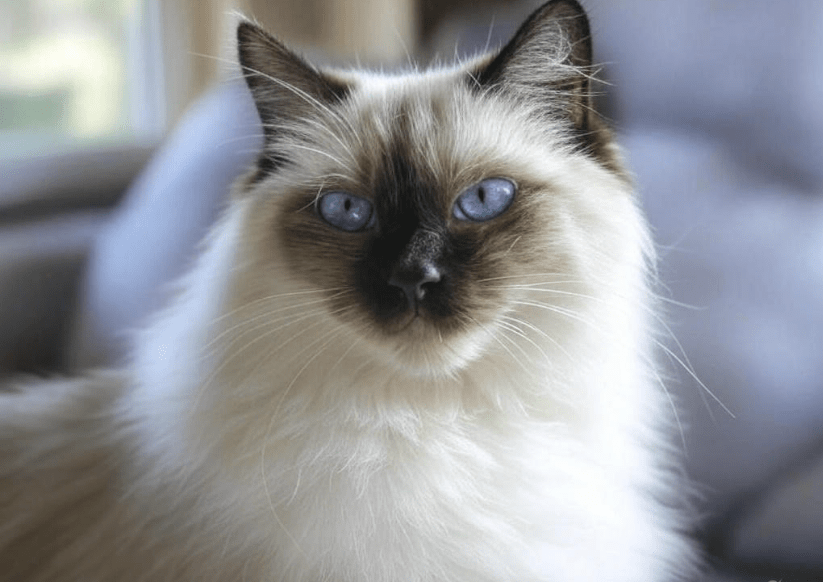
Ragdoll cats, with their luxurious semi-long coats and affectionate nature, are prone to hairballs, making it essential to prevent hairballs in Ragdoll cats naturally. These gentle felines often ingest loose fur while grooming, leading to uncomfortable hairballs that can cause vomiting or digestive issues. Fortunately, natural methods can significantly reduce hairball formation, keeping your Ragdoll healthy and happy. This comprehensive guide explores the causes of hairballs in Ragdolls, their risks, and eight vet-approved, natural strategies to prevent them, ensuring your cat’s coat and digestion remain in top condition.
Introduction to Ragdoll Cats and Hairball Concerns
Ragdolls are beloved for their striking blue eyes, docile temperament, and plush, semi-long fur. However, their beautiful coats come with a downside: a higher risk of hairballs due to frequent grooming. Learning how to prevent hairballs in Ragdoll cats naturally is crucial for owners who want to avoid synthetic remedies and promote their pet’s well-being holistically. Hairballs, while common, can lead to discomfort or serious health issues if not addressed.
This article provides a deep dive into why Ragdolls are prone to hairballs, the importance of prevention, and practical, natural solutions like grooming, diet, and hydration. Designed to be the ultimate resource for Ragdoll owners, it offers actionable advice to keep your cat’s digestive system healthy and their coat gleaming, aligning with your interest in high-quality, problem-solving content for cat owners.
Understanding Hairballs in Ragdoll Cats
Hairballs, or trichobezoars, are clumps of ingested fur that accumulate in a cat’s stomach or intestines, often expelled through vomiting. Ragdolls are particularly susceptible due to their grooming habits and coat type. Understanding hairballs is the first step to effective prevention.
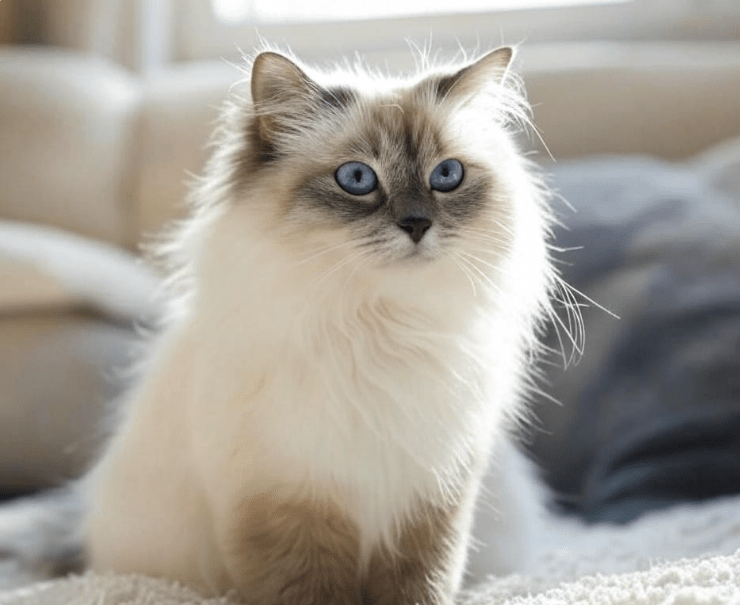
Why Are Ragdolls Prone to Hairballs?
Semi-Long Coats: Ragdolls’ dense, plush fur sheds regularly, and their fastidious grooming leads to swallowing loose hairs.
Frequent Grooming: Their love for cleanliness means more fur ingestion than short-haired breeds.
Relaxed Nature: Ragdolls’ sedentary tendencies can slow digestion, allowing hair to accumulate in the stomach.
Seasonal Shedding: Increased shedding during spring and fall exacerbates hairball formation.
Risks of Hairballs
While occasional hairballs are normal, frequent or severe cases can cause:
Discomfort: Vomiting or gagging can distress your Ragdoll.
Digestive Blockages: Large hairballs may obstruct the intestines, requiring veterinary intervention.
Reduced Appetite: Hairballs can cause nausea, leading to decreased food intake.
Lethargy: Chronic hairball issues may sap your cat’s energy.
Preventing hairballs naturally minimizes these risks, promoting your Ragdoll’s comfort and health.
Why Choose Natural Methods to Prevent Hairballs?
Natural hairball prevention aligns with a holistic approach, avoiding synthetic lubricants or medications that may have side effects. Benefits include:
Safety: Natural methods like grooming and diet are gentle and non-invasive.
Cost-Effectiveness: Many solutions use household items or affordable products.
Whole-Body Health: Natural strategies improve coat quality, digestion, and hydration.
Sustainability: Eco-friendly practices support long-term well-being.
This focus on natural solutions complements your interest in providing practical, health-focused content for Ragdoll owners, as seen in your previous articles on diet and grooming.
8 Natural Ways to Prevent Hairballs in Ragdoll Cats
Below are eight vet-approved, natural strategies to prevent hairballs in Ragdoll cats, designed to address the root causes of hairball formation while enhancing your cat’s overall health.
1. Regular Grooming to Reduce Loose Fur
Frequent brushing removes loose fur before your Ragdoll ingests it, significantly reducing hairball risk.
Why It Works: Brushing traps shed hair, preventing it from being swallowed during grooming—a topic you’ve explored in Ragdoll coat care.
How to Do It:
1.Brush 3–5 times weekly using a soft-bristled brush or de-shedding tool designed for semi-long coats.
2.Focus on high-shed areas like the back, belly, and tail.
3.Use gentle strokes to avoid skin irritation, praising your cat to make it enjoyable.
Tools: Opt for a slicker brush or grooming glove, such as the Hertzko Self-Cleaning Slicker Brush.
Pro Tip: Groom during shedding seasons (spring/fall) daily to manage increased fur loss.
Benefit: Reduces ingested fur and strengthens your bond, as discussed in your bonding article.
2. Optimize Diet for Digestive Health
A high-quality, fiber-rich diet helps move ingested fur through the digestive tract, preventing hairball formation.
Why It Works: Fiber promotes regular bowel movements, while proper nutrition supports coat health, reducing shedding.
How to Do It:
1.Choose wet or dry food with natural fiber sources like pumpkin, psyllium, or beet pulp.
2.Ensure adequate protein (e.g., chicken or fish) and taurine for coat and digestive health.
3.Avoid fillers like corn or soy, which can irritate digestion.
Examples: Try Royal Canin Hairball Care or Blue Buffalo Sensitive Stomach Formula.
Pro Tip: Add a teaspoon of canned pumpkin (pure, not pie filling) to meals weekly for extra fiber.
Benefit: Aligns with your diet-focused content, promoting overall health and weight management.
3. Encourage Hydration to Aid Digestion
Proper hydration softens ingested fur, helping it pass through the digestive system more easily.
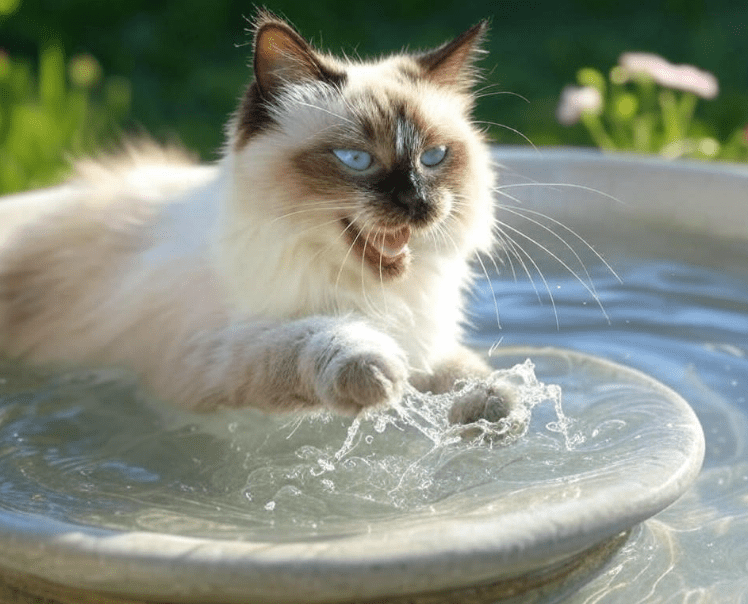
Why It Works: Moist food and water lubricate the digestive tract, reducing hairball accumulation.
How to Do It:
1.Provide fresh water daily in a wide, shallow bowl or pet fountain, as Ragdolls prefer running water.
2.Incorporate wet food into their diet to increase moisture intake.
3.Place multiple water stations around the home to encourage drinking.
Tools: Consider a Catit Flower Fountain for its appealing design and flow.
Pro Tip: Add a splash of low-sodium chicken broth to water to entice picky drinkers.
Benefit: Supports urinary health, a concern you’ve addressed in Ragdoll care articles.
4. Use Natural Fiber Supplements
Safe, natural supplements like pumpkin or psyllium husk can enhance fiber intake, aiding hairball passage.
Why It Works: Fiber bulks up stool, helping hair move through the intestines without clumping.
How to Do It:
1.Mix ½–1 teaspoon of canned pumpkin into food 2–3 times weekly.
2.Use vet-approved psyllium husk powder in small doses, mixed with wet food.
3.Consult your vet before introducing supplements to ensure suitability.
Products: Weruva Pumpkin Patch Up! is a convenient, cat-safe option.
Pro Tip: Start with small amounts to avoid digestive upset and monitor stool consistency.
Benefit: Non-invasive and aligns with natural, holistic care.
5. Promote Exercise to Stimulate Digestion
Regular physical activity supports healthy digestion, helping ingested fur pass through the system.
Why It Works: Movement stimulates intestinal motility, preventing hair from stagnating—a concept you’ve tied to mental stimulation in puzzle feeder articles.
How to Do It:
1.Engage in 10–15 minutes of play twice daily using feather wands, laser pointers, or balls.
2.Install a cat tree or shelves to encourage climbing and jumping.
3.Use puzzle feeders to combine exercise with mental engagement.
Pro Tip: Rotate toys to maintain interest and mimic prey movements for maximum engagement.
Benefit: Reduces obesity risk, a recurring theme in your Ragdoll health content.
6. Maintain a Stress-Free Environment
Stress can slow digestion, increasing hairball risk, so a calm environment is key.
Why It Works: Relaxed Ragdolls have better digestive function, reducing hair accumulation.
How to Do It:
1.Provide safe spaces like cozy beds or hiding spots for retreat.
2.Maintain a consistent routine for feeding, play, and grooming, as emphasized in your routine-focused articles.
3.Minimize loud noises, sudden changes, or unfamiliar visitors.
Tools: Consider Feliway diffusers for added calming effects.
Pro Tip: Use slow blinks and soft voices to reinforce a soothing atmosphere.
Benefit: Reduces anxiety-related clinginess, as discussed in your behavior articles.
7. Offer Cat-Safe Grass for Digestion
Cat grass, like wheatgrass or oat grass, promotes vomiting or digestion, helping clear hair from the stomach.
Why It Works: Grass acts as a natural laxative or induces vomiting to expel hairballs safely.
How to Do It:
1.Grow cat-safe grass in pots or buy pre-grown kits from pet stores.
2.Place grass in an accessible spot and supervise to prevent overeating.
3.Replace grass regularly to ensure freshness.
Products: Try Pet Greens Self-Grow Kit for convenience.
Pro Tip: Introduce grass gradually to avoid digestive upset.
Benefit: Provides a natural, plant-based solution for hairball control.
8. Monitor and Address Excessive Shedding
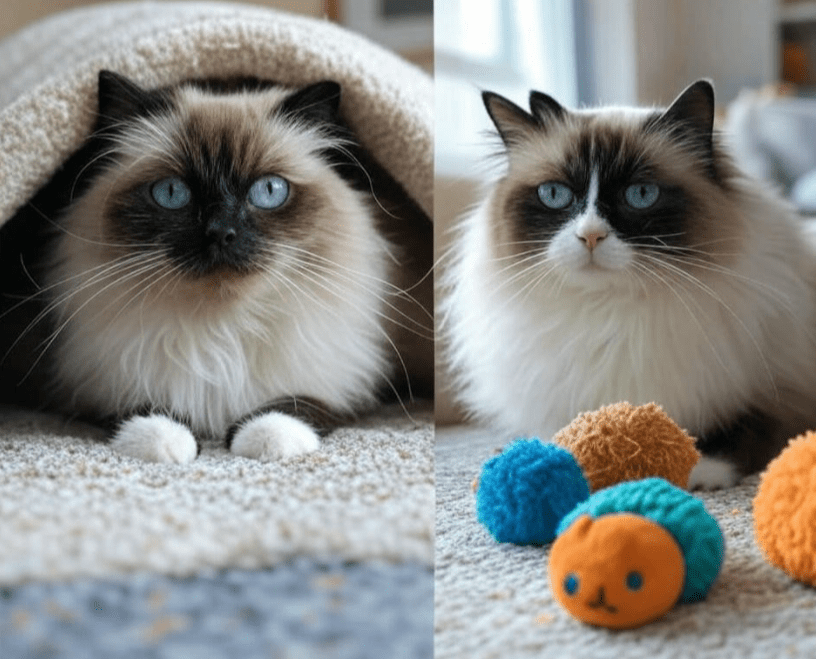
Reducing shedding through grooming and health checks minimizes the fur available for ingestion.
Why It Works: Less loose fur means fewer hairballs, addressing the root cause.
How to Do It:
1.Check for skin issues, allergies, or dietary deficiencies that increase shedding.
2.Use omega-3 supplements (e.g., fish oil) to improve coat health, with vet approval.
3.Schedule annual vet checkups to rule out medical causes of excessive shedding.
Pro Tip: Brush before feeding to collect loose fur and reduce ingestion during grooming.
Benefit: Enhances coat beauty, a topic you’ve covered in Ragdoll grooming.
When to Seek Veterinary Help
While natural methods are effective, persistent hairball issues may require professional attention. Consult a vet if your Ragdoll shows:
Frequent Vomiting: More than one hairball per month or repeated gagging without expulsion.
Loss of Appetite: Refusing food for over 24 hours.
Lethargy: Unusual tiredness or lack of interest in play.
Constipation: Straining in the litter box or no bowel movements for 48 hours.
Abdominal Pain: Hunching, sensitivity to touch, or vocalizing when handled.
Your vet may recommend diagnostics (e.g., X-rays) or treatments like laxatives, ensuring your Ragdoll’s safety.
Common Mistakes to Avoid
When preventing hairballs, steer clear of these pitfalls:
Overusing Supplements: Excessive fiber can cause diarrhea or nutrient imbalances.
Neglecting Grooming: Infrequent brushing allows more fur ingestion.
Using Human Products: Human laxatives or oils are toxic to cats.
Ignoring Symptoms: Dismissing frequent hairballs as “normal” may overlook blockages.
Inconsistent Routines: Sporadic grooming or feeding disrupts prevention efforts.
Conclusion
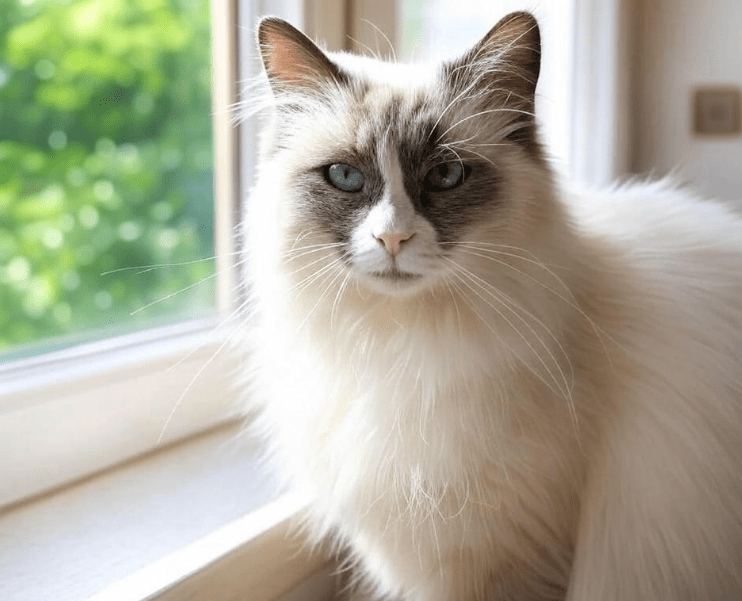
Preventing hairballs in Ragdoll cats naturally is achievable with a holistic approach that addresses grooming, diet, hydration, and lifestyle. By implementing these eight strategies—regular brushing, fiber-rich diets, hydration, supplements, exercise, stress reduction, cat grass, and shedding management—you can keep your Ragdoll’s digestive system healthy and their coat pristine. These methods align with your goal of creating high-value, problem-solving content, offering Ragdoll owners practical solutions to a common issue.
Start with one or two strategies today, and monitor your Ragdoll’s progress. For persistent issues, consult your veterinarian for tailored advice. With consistent care, you’ll ensure your Ragdoll enjoys a hairball-free, comfortable life, strengthening your bond along the way.


